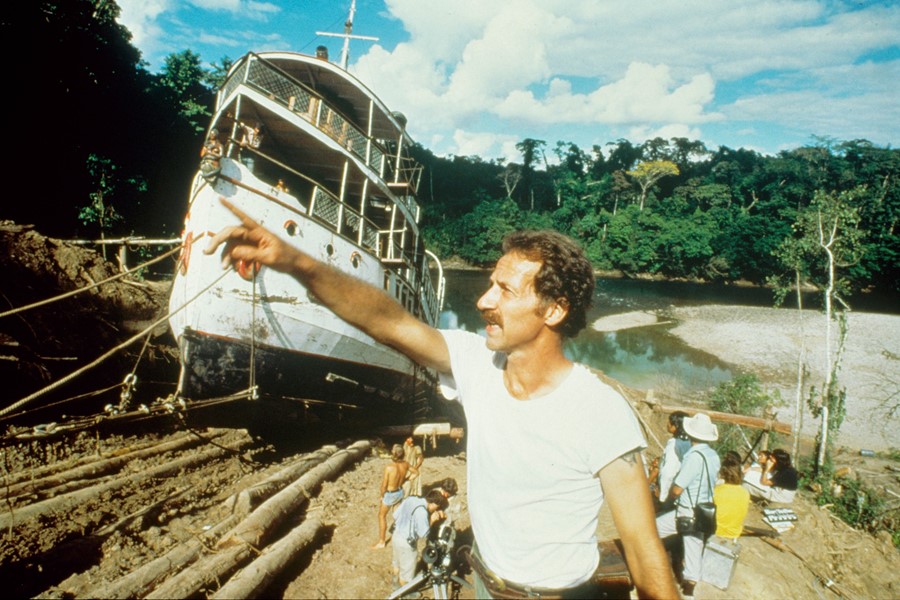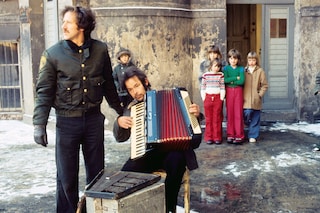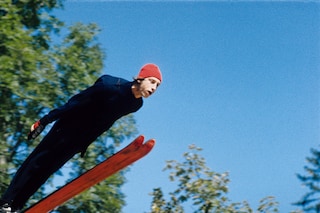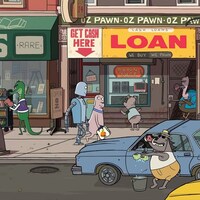From dragging steamboats over mountains, to holding Klaus Kinski at gunpoint, Herzog’s career has been guided by a quest for ‘ecstatic truth’, explored in a new exhibition at Amsterdam’s EYE Filmmuseum
On April 30, 1999, Werner Herzog delivered – in his iconic Bavarian monotone – a manifesto titled “Lessons of Darkness” at the Walker Art Center in Minneapolis. The now-famous Minnesota Declaration outlined his opposition to documentary filmmaking that makes claims to represent an objective, unaltered version of reality. “So-called Cinema Verité is devoid of verité. It reaches a merely superficial truth, the truth of accountants,” he said. “Filmmakers of Cinema Verité resemble tourists who take pictures of ancient ruins of facts.”
In his own films, on the other hand, the director says that he is after “something deeper, a deeper stratum of truth”. At that talk in 1999, he coined a name for what he was seeking: ecstatic truth. “It is mysterious and elusive,” he said, “and can be reached only through fabrication and imagination and stylization.”
Anyone familiar with Herzog’s films will have encountered this pursuit of ecstatic truth. It can be found in the monomaniacal quest of Fitzcarraldo, the opera enthusiast played by Klaus Kinski in Herzog’s 1982 film of the same name, who drags a 320-ton steamboat over a mountain in an effort to establish an opera house in the middle of the jungle. It can be found in the slow-motion bats and rat-laden banquet tables of Herzog’s Nosferatu the Vampyre (also starring Kinski, in a truly disturbing portrayal of Count Dracula). This is “more than a horror film,” according to Herzog, and – like its leading actress, Isabelle Adjani, quoting the Bram Stoker novel – it calls on us to employ an element of faith, “the amazing faculty of man, which enables us to believe things which we know to be untrue”.
However, Herzog’s search for the “illumination” of ecstatic truth goes beyond just his fictional work, where the suspension of disbelief comes easily. In his many documentaries, the filmmaker also has a habit of aestheticising reality for his viewers, in some cases completely fabricating the events on the screen. The surreal image of post-Soviet pilgrims slithering on their stomachs across a frozen lake in Bells From the Deep, his 1993 documentary on Russian mysticism? Not only were the hallucinated bells added in post-production (obviously) but Herzog himself admits that the “pilgrims” were actually just drunken men he’d found in a nearby village.
Other times, the invention of ecstatic truths is more subtle. This is the case toward the end of the documentary Cave of Forgotten Dreams, when Herzog takes a sharp left-turn away from his subject matter (the 32,000-year-old wall paintings in Chauvet Cave) and goes to visit some “mutant” albino crocodiles living in a greenhouse heated by the runoff from a nearby nuclear power plant. “Fairly soon, these albinos might reach Chauvet caves,” he says. “Looking at the paintings, what will they make of them? Nothing is real. Nothing is certain. [...] Are we today the crocodiles who look back into the abyss of time when we see the paintings of Chauvet cave?”
It’s a typically Herzogian line of questioning, unpicking how humans perceive the world, while hinting at a post-human future, or that civilisation is just a blip on the timeline of the universe. Earlier in that same film, he blindsides a researcher – who has spent years assembling a 3D model of the cave from millions of individual data points – with another characteristically cryptic question. “It is like you’re creating the phone directory of Manhattan,” he says. “4 million precise entries, but do they dream? Do they cry at night? What are their hopes?” At another point, an “experimental archeologist” plays “The Star-Spangled Banner” on a bone flute. At yet another point, a perfumer shows Herzog how to sniff out hidden caves.
These interviews act as funny asides, embracing intense outsider figures the way Herzog always has (see also: Timothy Treadwell, the wildlife researcher in 2005’s Grizzly Man; Swiss ski jumper Walter Steiner; Klaus Kinski). However, they also provide a mystical counterpoint to the facts provided by the archaeological experts. “Nobody can exactly define what the truth is,” Herzog explains, in an interview broadcasted during the opening of a new, career-spanning exhibition at Amsterdam’s EYE Filmmuseum. Nevertheless: “The act of trying is important.”
Titled Werner Herzog: The Ecstatic Truth, the EYE exhibition is thematically linked by the ideas outlined in the Minnesota Declaration, plus Herzog’s 2017 edits that make reference to more recent developments, such as the increased urgency of questions of truth in an era of “alternative facts”. Visitors enter through a room of screens that show Herzog discussing his life and work, in interviews as well as making of documentaries such as Burden of Dreams, before they’re faced with large-scale projections of iconic scenes from Herzog’s expansive filmography – from Even Dwarfs Started Small and Fata Morgana, to Grizzly Man and Encounters at the End of the World. Conceived in cooperation with Deutsche Kinemathek, Berlin, which manages the Werner Herzog Archive, and Lucki Stipetić – Herzog’s brother, who has produced his films since 1972’s Aguirre, the Wrath of God and continues to “make his impossible visions possible” – the exhibition also features documents and props, including a mosquito-spattered script carried deep in the Peruvian rainforest, and the bloodied fangs and fingernails that helped create Kinski’s Count Dracula.
With these materials gathered in one place, a few common threads emerge, running throughout Herzog’s career: isolated rebels are elevated to an ambiguous form of stardom, landscapes are treated less as backdrops and more like actors in themselves (which Herzog “directs” alongside the humans and animals in his films) and, of course, reality is always depicted in an intensified state, whether that’s because of the characters’ external circumstances or their inner turmoil. What EYE also draws out, however, is how Herzog’s search for ecstatic truth goes beyond what we see on the screen, bleeding into real life via trials and tribulations that mirror the obsessive nature of the characters he invents. After all, this is the man who made a film about a crazy scheme to drag a steamboat over a mountain by… dragging a steamboat over a mountain, and filming it.
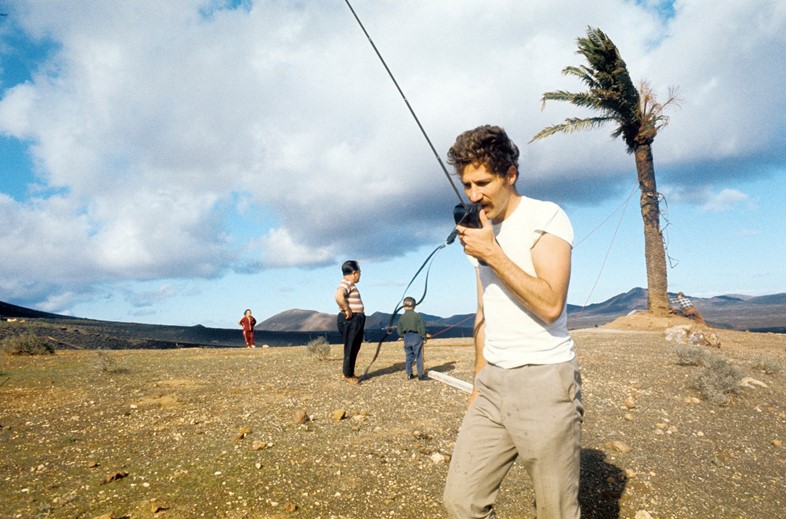
Herzog’s stylisation has caused controversy in the past. 1992’s Lessons of Darkness sets scenes from the aftermath of the Gulf War – vast lakes of oil flooding the burnt landscape, reflecting towers of smoke and fire – to grandiose overtures by Wagner. On the film’s release, Herzog was condemned by critics, who said he was aestheticising the atrocities committed in Kuwait. (In response, he argued that what he’d produced was a “requiem” in the style of Goya or Hieronymous Bosch.) Similar criticisms were made against Grizzly Man, though the director leaves the audience to imagine the sounds of Treadwell’s gruesome death while he listens through a pair of headphones, as well as 2013’s On Death Row.
More pressing controversies, in 2023, are Herzog’s relationships with the real people involved in making his creative obsessions a reality. For a viewership that’s increasingly concerned with the artist behind the art, the material conditions behind Herzog’s ecstatic images have come under more scrutiny. The most obvious example of this is his tempestuous relationship with Kinski, which Herzog himself explored in My Best Fiend. On set, Kinski was demanding at best, and dangerous at worst, clashing with the director, extras, Stipetić and other crew members. Herzog himself resorted to threats of violence to keep Kinski under control, infamously threatening to put a bullet in the actor (and then himself) when he tried to leave the jungle before filming wrapped. By this point, Kinski was already known to be a volatile figure, with a history of violence and mental illness; in 2013, more than 20 years after his death, his daughter also shared allegations of sexual abuse.
Should Herzog have made a leading man of this “demon” in no less than five of his films? (Tellingly, few directors worked with him more than once.) According to Herzog, he had no choice: Kinski was just one of a few actors in the world, he said, who had the talent and intensity for his roles. “Kinski has something beyond talent, beyond recognition, beyond professionalism,” he told Film Comment in 1979, the year Kinski starred in two of his films, Nosferatu and Woyzeck. “It is unique and can’t be explained.”
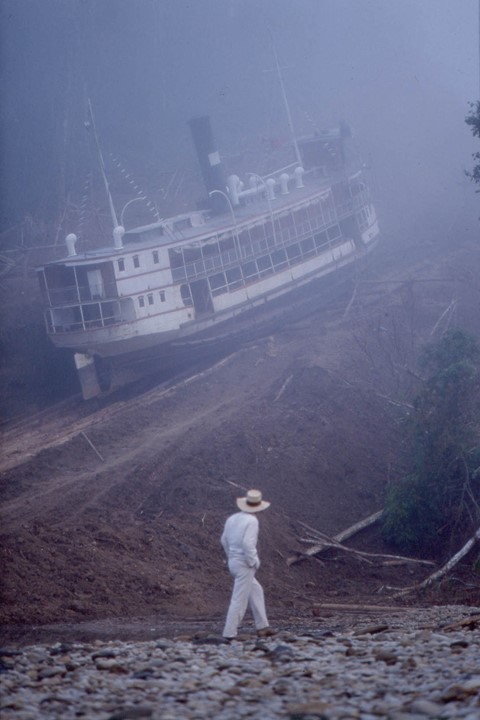
Another common criticism of Herzog’s daring, and frequently dangerous, directing style has revolved around other actors and extras who have featured in his productions. During the ill-fated production of Fitzcarraldo, an international campaign claimed that the filmmaker was exploiting native tribespeople, claims that weren’t helped by a number of disasters that subsequently took place among the cast and crew, including a fatal drowning, plane crashes, serious illness, and outbreaks of war. Contemporary reappraisals have also condemned the treatment of people of short stature in Even Dwarfs Started Small (one of whom was run over and caught on fire during filming, without sustaining any serious injuries).
Unable to hear the stories firsthand from the actors themselves, the EYE Filmmuseum did the next best thing, consulting a range of voices, including Peruvian filmmakers, disability advocates, and an intimacy coach, for their thoughts on Herzog’s career. Some of the findings were surprising, the curators say at the exhibition opening, and opinions were rarely black and white. While Herzog was praised for casting native populations – a directorial decision that’s still rare, in 2023 – he was also criticised for his depiction of Aguirre’s maniacal relationship with his followers. While a person of short stature said that they liked being able to identify with complex roles in Herzog’s films, they also objected to his treatment of animals. As the curators note: “He never avoids controversy: the Herzog film that does not provoke discussion has yet to be made.”
In pushing the boundaries of what’s acceptable to bring his cinematic visions to life – something he actively encourages at his aptly-named film school, Rogue – Herzog has also pushed the boundaries of cinema itself, and produced some of the most indelible images of his generation. The director is the first to admit that great films require taking risks, whether those risks are physical, legal, or reputational. As a result, his brand of filmmaking is in direct opposition to the safe, sterile images created in Hollywood blockbusters, glossy ad campaigns, and tourist brochures. (Another Lesson of Darkness: “Tourism is sin, and travel on foot virtue.”) These ubiquitous images, he says, “are not adequate for our situation”. Only through “fabrication and imagination and stylization” can we really figure out the deeper truth of our existence in today’s surreal world.
Werner Herzog: The Ecstatic Truth runs at EYE Filmmuseum until October 1, alongside a programme of the director’s films.
Join Dazed Club and be part of our world! You get exclusive access to events, parties, festivals and our editors, as well as a free subscription to Dazed for a year. Join for £5/month today.
